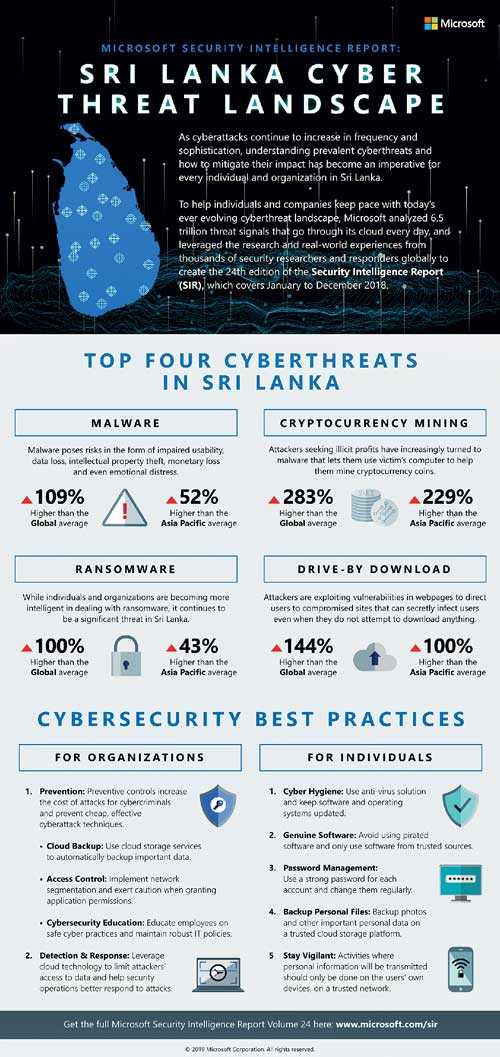Wednesday Nov 26, 2025
Wednesday Nov 26, 2025
Tuesday, 9 April 2019 00:00 - - {{hitsCtrl.values.hits}}
As the country embarks on ambitious tech projects, more companies are likely to be exposed to attacks than the global average. Even as businesses capitalise on the latest security intelligence and protections to stay ahead in the evolving cybersecurity landscape, Sri Lanka continues to be an attractive region for cybercriminals according to Microsoft.
The 24th edition of Microsoft’s Security Intelligence Report comprises of core insights and key trends derived by sifting through data between January to December 2018 from multiple, diverse sources, including 6.5 trillion threat signals that go through the Microsoft cloud every day. The report is a reflection on last year’s security events and includes an overview of the security landscape, lessons learned from the field, and recommended best practices.
“Undoubtedly, cybersecurity is one of the most pressing issues for organisations today. As cyberattacks continue to increase in frequency and sophistication, understanding prevalent cyberthreats and how to limit their impact has become an imperative,” said Microsoft Sri Lanka and Maldives Country Manager Hasitha Abeywardena.

Cryptocurrency mining malware becomes increasingly prevalent in Sri Lanka
With the rise in value of cryptocurrency, such as Bitcoin, cybercriminals seeking illicit profits have turned to malware that lets them use victims’ computers to mine cryptocurrency coins. This approach allows them to leverage the processing power of hundreds of thousands of computers. Even when a minor infection is discovered, the anonymous nature of cryptocurrency complicates efforts to track down the responsible parties.
The study found that between January to December 2018, the cryptocurrency mining malware encounter rate – the percentage of computers running Microsoft real-time security products that report a malware encounter – in Sri Lanka was 283% higher than the global average and 229% higher than the Asia Pacific average, the highest encounter rate in the region. The report also found that the encounter rate increased or decreased with the rise or fall in the value of cryptocurrency.
Many factors have contributed to the increased popularity of mining as a payload for malware. Unlike ransomware, cryptocurrency mining does not require user input: it works in the background, while the user is performing other tasks or is away from the computer, and may not be noticed at all unless it degrades the computer’s performance sufficiently. As a result, users are less likely to take any action to remove the threat, and it might continue mining for the benefit of the attacker for an extended period of time.
Another driver of the trend is the availability of “off the shelf” products for covert mining of many cryptocurrencies. The barrier to entry is low because of the wide availability of coin mining software, which cybercriminals repackage as malware to deliver to unsuspecting users’ computers. The weaponised miners are then distributed to victims using many of the same techniques that attackers use to deliver other threats, such as social engineering, exploits, and drive-by downloads.
Ransomware still a threat in Sri Lanka despite a decline in the number of attacks
According to the study, ransomware encounters have decreased by 73% worldwide. However, despite the decline, ransomware is still a viable threat in Sri Lanka as the country’s encounter rate was 100% more than the global average.
One of the key reasons contributing to the fall of ransomware attacks is the organisations and individuals becoming more aware of and dealing more intelligently with ransomware threats, including exerting greater caution and backing up important files so they can be restored if encrypted by ransomware. While organisations and consumers are encountering ransomware at lower volumes compared to the previous year, it does not mean the severity of attacks has declined. It is still capable of making real-world impact by affecting corporate networks and crippling critical services such as hospitals, transportation, and traffic systems.
Cybercriminals continue to deliver malicious code through drive-by download pages
Although drive-by download encounters globally has decreased by 22%, Sri Lanka experienced approximately 144% more drive-by download attacks than the rest of the world. The highest concentration of drive-by download pages were in Taiwan, Malaysia and Indonesia.
A drive-by download is an unintentional download of malicious code to an unsuspecting user’s computer when they visit a website. The malicious code could be used to exploit vulnerabilities in web browsers, browser add-ons, applications, and the operating system. Users can be infected with malware simply by visiting a website, even without attempting to download anything. More advanced drive-by download campaigns can also install ransomware or even cryptocurrency mining software on a victim machine.
Sri Lanka among the most vulnerable to malware
Malware poses risks to organisations and individuals in the form of impaired usability, data loss, intellectual property theft, monetary loss, emotional distress, and can even put human life at risk. While the global malware encounter rate has decreased by 34%, the malware encounter in Sri Lanka was 109% more than the global average, highlighting the correlation of infection rates with human development factors and technology readiness within a society.
The report also found that the Asia Pacific markets with the lowest malware encounter rates are Japan, Australia and New Zealand. These locations tend to have mature cybersecurity infrastructures and well-established programs for protecting critical infrastructure and communicating with their citizens about basic cybersecurity best practices.
“To strengthen individuals’ trust in technology and prevent cyberattacks from derailing companies’ digital transformation initiatives, cybersecurity professionals need to devise a holistic strategy that includes prevention and detection and response. Measures such as preventive controls as well as the adoption of cloud and artificial intelligence to augment security operations will play a vital role in building organizational resilience and facilitating meaningful risk reduction within their organisation,” Abeywardena concluded.
To learn more about the latest cyberthreat trends as well as the best practices that organisations can adopt, visit https://www.microsoft.com/sir.